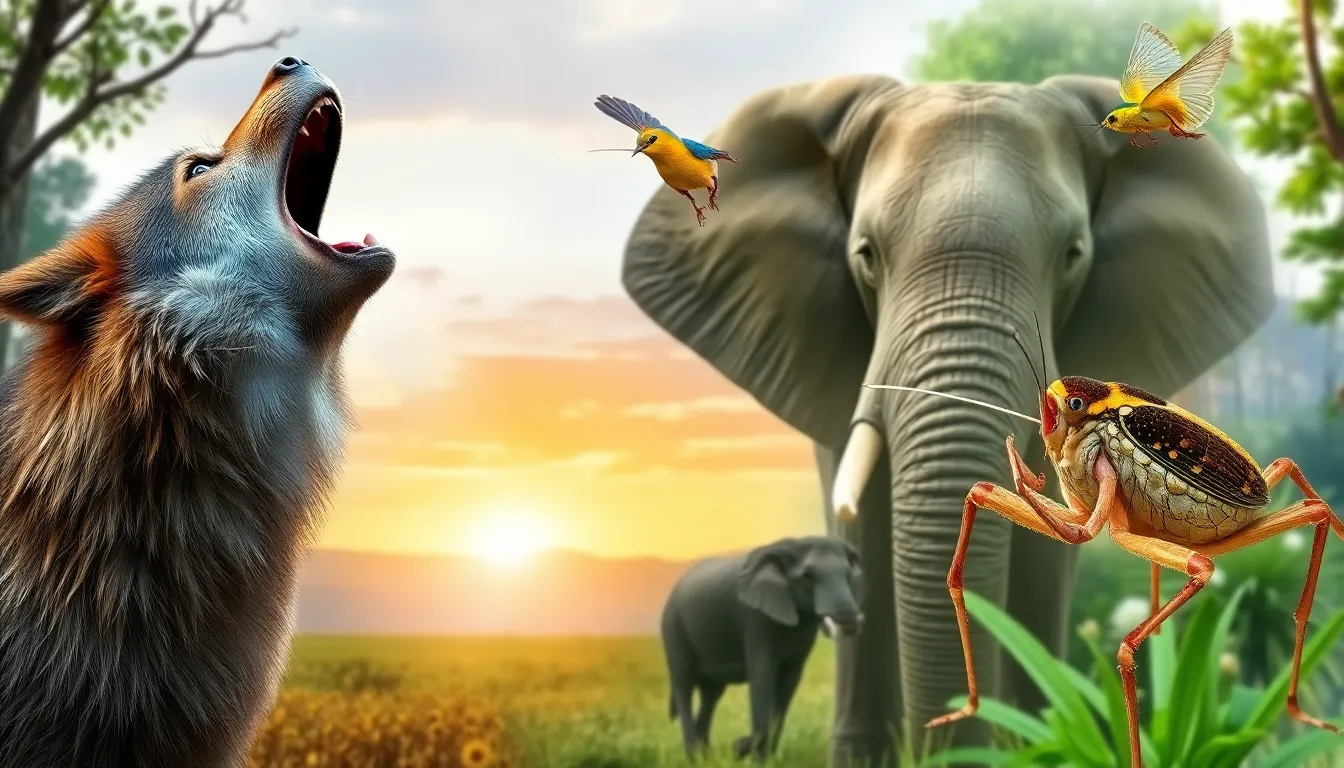Table of Contents
ToggleAnimal sounds are more than just noise; they’re a vital part of communication in the animal kingdom. From the haunting call of a wolf to the cheerful chirp of a sparrow, these sounds convey emotions, establish territory, and attract mates. Understanding these vocalizations opens a window into the lives of animals, revealing their behaviors and social structures.
Each species has its own unique repertoire, shaped by its environment and evolutionary history. Whether it’s the deep roar of a lion or the gentle coo of a dove, these sounds play a crucial role in survival. By exploring the fascinating world of animal sounds, one can appreciate the complexity and richness of life on Earth.
Understanding Animal Sounds
Animal sounds constitute a vital communication method within the animal kingdom. These vocalizations provide insights into behaviors and social structures.
Definition of Animal Sounds
Animal sounds refer to vocalizations made by various species for communication purposes. These sounds can include growls, barks, chirps, whistles, and roars. Each animal species produces a distinct range of sounds, shaped by factors such as anatomy, habitat, and social behavior. Vocalizations serve as signals that relay information between individuals, aiding in interactions like warning others of danger or coordinating group movements.
Importance of Animal Sounds
Animal sounds fulfill several critical functions within various ecosystems.
- Communication: Sounds convey information about food availability, potential threats, and social interactions, enhancing cooperation among species.
- Territorial Claims: Many animals use vocalizations to establish territorial boundaries. For instance, wolves howl to assert their presence and deter intruders.
- Mating Signals: Many species utilize distinct calls during mating seasons to attract partners. For example, frogs croak to signal readiness to mate, increasing reproductive success.
- Emotional Expression: Sounds often express emotions such as distress, aggression, or contentment. For instance, domestic cats purr when relaxed and hiss when threatened.
Understanding these aspects of animal sounds reveals their significance in promoting survival and social dynamics within various species.
Types of Animal Sounds

Animal sounds can be classified into two main categories: vocalizations and non-vocal sounds. Each type serves distinct purposes and showcases the diversity of communication methods across species.
Vocalizations
Vocalizations encompass sounds produced by the vocal cords, including growls, barks, chirps, and roars. These sounds facilitate communication for various reasons. They convey emotions, such as excitement or fear, and serve as signals for mating, territory establishment, or warnings of danger. For example, wolves use howls to communicate their location and strengthen social bonds within packs. Birds employ chirps and songs to attract mates and mark their territory. Each vocalization varies in pitch, duration, and frequency, reflecting the specific needs of the species and its environment.
Non-vocal Sounds
Non-vocal sounds consist of auditory signals not produced by vocal cords, including clicks, grunts, and body-generated noises. These sounds often result from physical actions or interactions with the environment. For instance, elephants use low-frequency rumbles that vibrate through the ground, allowing communication over long distances. Insects such as crickets produce sounds by rubbing their wings together, known as stridulation, to attract mates. These non-vocal sounds are essential for conveying information about environmental conditions, social interactions, and potential threats, enhancing survival chances in various ecosystems.
Functions of Animal Sounds
Animal sounds serve essential functions in the animal kingdom, facilitating communication, territorial marking, and mate attraction among various species.
Communication
Communication relies heavily on vocalizations. Animals utilize sounds to convey emotions, alert others of danger, or establish social bonds. For instance, primates use different calls to warn of predators, while dolphins communicate through a series of clicks and whistles. Various species employ specific sounds to indicate danger, food availability, or the presence of other group members. Each sound not only provides immediate information but also strengthens social cohesion within groups, enhancing survival and cooperation.
Territorial Marking
Territorial marking often involves loud vocalizations that establish boundaries. Many animals, such as wolves and lions, use prominent calls to announce their presence and deter intruders. These sounds serve as a warning to others, signaling ownership of a specific area. For example, male frogs croak to claim their territory during mating season, while birds sing to delineate their nesting zones. This vocal behavior minimizes physical confrontations, promoting stability within ecosystems by reducing conflicts over space and resources.
Animal Sounds in Different Species
Animal sounds vary significantly across species, showcasing the diversity of communication methods used in the animal kingdom. Understanding these variations enhances appreciation for the adaptations that different animals develop for survival.
Mammals
Mammals produce a wide range of vocalizations, often influenced by their social structures and environmental contexts.
- Dogs: Dogs bark, whine, and growl to express emotions and communicate needs. Each bark can vary in pitch and length, conveying excitement or distress.
- Cats: Cats meow primarily to interact with humans. They also use purring to indicate contentment and hissing as a warning signal.
- Whales: Whales produce complex songs, particularly among humpback whales. These vocalizations can travel thousands of miles underwater, helping them communicate over long distances.
Birds
Birds are known for their distinct songs and calls, which serve multiple purposes in their daily lives.
- Sparrows: Sparrows chirp to establish territory and attract mates. Their songs vary regionally, showcasing the influence of local environments.
- Doves: Doves coo softly, signaling comfort and courtship. This low-frequency sound is often a precursor to mating behavior.
- Parrots: Parrots mimic sounds and voices, demonstrating high cognitive flexibility. Their vocalizations can reflect their social interactions and emotional states.
Reptiles
Reptiles use more subtle sounds compared to mammals and birds, often relying on body language and behavioral displays.
- Snakes: Some snakes hiss as a defensive mechanism. This sound warns potential threats and establishes their presence in a territory.
- Lizards: Certain lizards perform vocalizations during mating rituals. These calls attract females and can indicate the health and vitality of the male.
- Tortoises: Tortoises make low-frequency sounds, often during mating or territorial disputes. These vocalizations can signify distress or assertiveness to competitors.
Understanding these animal sounds reinforces knowledge of the diverse communication strategies used by different species, highlighting the intricate connections within ecosystems.
Human Interaction with Animal Sounds
Human interaction with animal sounds encompasses research initiatives and conservation efforts focused on understanding and protecting the diverse forms of communication in the animal kingdom. The study of these sounds provides insights into animal behaviors and their ecological significance.
Study and Research
Research on animal sounds contributes to various scientific fields, including ethology and bioacoustics. Ethologists analyze vocalizations to understand social structures and relationships among species. For instance, studies on wolf howls reveal their significance in pack coordination, territory establishment, and social bonding. Bioacoustics, on the other hand, involves the recording and analysis of sounds made by animals in their natural habitats, enhancing knowledge of communication patterns across species.
Additionally, researchers employ advanced technology such as acoustic sensors and spectrogram analysis to decode complex vocalizations. Projects like the Macaulay Library archive hundreds of thousands of animal sounds, aiding scientists, conservationists, and enthusiasts in identifying species and monitoring their behavior. This body of research underscores the importance of animal sounds and their role in ecosystem health and stability.
Conservation Efforts
Conservation initiatives increasingly recognize the value of animal communication in protecting biodiversity. Efforts focus on monitoring habitats using sound to assess wildlife populations and their interactions within ecosystems. For example, researchers use acoustic monitoring to detect the presence of endangered species such as the California condor, which relies on specific vocalizations for social interactions.
Furthermore, conservation programs aim to mitigate anthropogenic noise pollution, which disrupts natural communication among animals. Effective strategies include implementing noise barriers in urban areas and minimizing traffic near critical habitats. By understanding animal sounds and their functions, conservationists enhance these strategies, ultimately promoting healthier ecosystems that support biodiversity and resilience.
Animal sounds are a remarkable aspect of life that reveals the intricate relationships within ecosystems. These vocalizations not only facilitate communication but also play crucial roles in survival and social dynamics. As research continues to uncover the complexities of animal sounds, it becomes increasingly clear how vital they are for understanding biodiversity and the health of our planet. By appreciating and protecting these unique forms of communication, society can contribute to the conservation of diverse species and the ecosystems they inhabit. The future of wildlife depends on recognizing the importance of these sounds and the roles they play in maintaining the delicate balance of nature.





